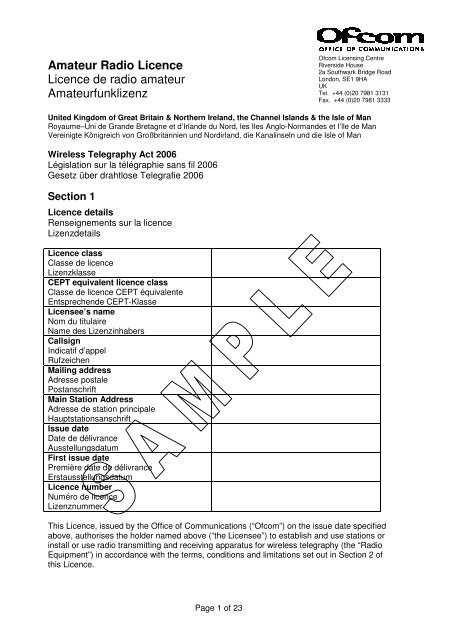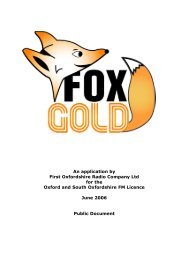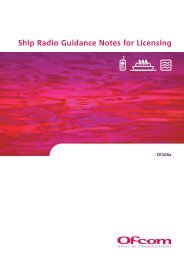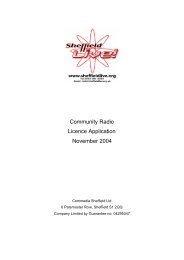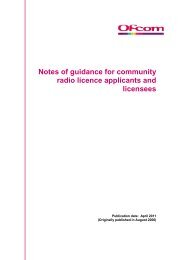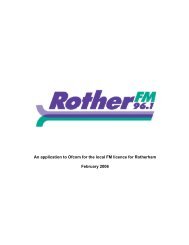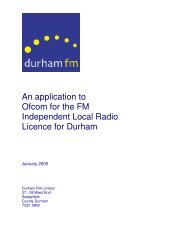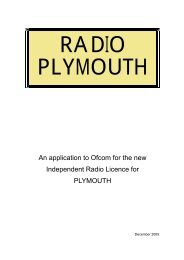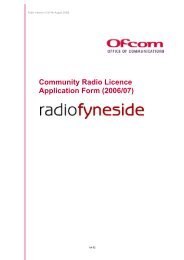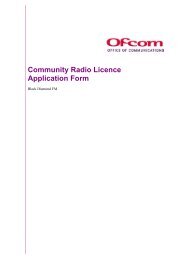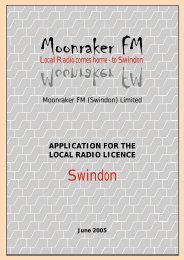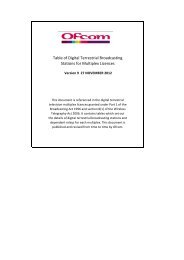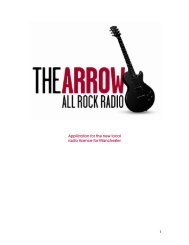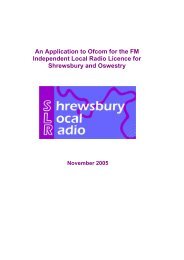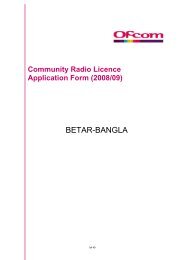Lifetime Sample Amateur Radio Licence ... - Ofcom Licensing
Lifetime Sample Amateur Radio Licence ... - Ofcom Licensing
Lifetime Sample Amateur Radio Licence ... - Ofcom Licensing
Create successful ePaper yourself
Turn your PDF publications into a flip-book with our unique Google optimized e-Paper software.
<strong>Amateur</strong> <strong>Radio</strong> <strong>Licence</strong><br />
<strong>Licence</strong> de radio amateur<br />
<strong>Amateur</strong>funklizenz<br />
Page 1 of 23<br />
<strong>Ofcom</strong> <strong>Licensing</strong> Centre<br />
Riverside House<br />
2a Southwark Bridge Road<br />
London, SE1 9HA<br />
UK<br />
Tel. +44 (0)20 7981 3131<br />
Fax. +44 (0)20 7981 3333<br />
United Kingdom of Great Britain & Northern Ireland, the Channel Islands & the Isle of Man<br />
Royaume–Uni de Grande Bretagne et d’Irlande du Nord, les Iles Anglo-Normandes et I’lle de Man<br />
Vereinigte Königreich von Großbritannien und Nordirland, die Kanalinseln und die Isle of Man<br />
Wireless Telegraphy Act 2006<br />
Législation sur la télégraphie sans fil 2006<br />
Gesetz über drahtlose Telegrafie 2006<br />
Section 1<br />
<strong>Licence</strong> details<br />
Renseignements sur la licence<br />
Lizenzdetails<br />
<strong>Licence</strong> class<br />
Classe de licence<br />
Lizenzklasse<br />
CEPT equivalent licence class<br />
Classe de licence CEPT équivalente<br />
Entsprechende CEPT-Klasse<br />
Licensee’s name<br />
Nom du titulaire<br />
Name des Lizenzinhabers<br />
Callsign<br />
Indicatif d’appel<br />
Rufzeichen<br />
Mailing address<br />
Adresse postale<br />
Postanschrift<br />
Main Station Address<br />
Adresse de station principale<br />
Hauptstationsanschrift<br />
Issue date<br />
Date de délivrance<br />
Ausstellungsdatum<br />
First issue date<br />
Première date de délivrance<br />
Erstausstellungsdatum<br />
<strong>Licence</strong> number<br />
Numéro de licence<br />
Lizenznummer<br />
This <strong>Licence</strong>, issued by the Office of Communications (“<strong>Ofcom</strong>”) on the issue date specified<br />
above, authorises the holder named above (“the Licensee”) to establish and use stations or<br />
install or use radio transmitting and receiving apparatus for wireless telegraphy (the “<strong>Radio</strong><br />
Equipment”) in accordance with the terms, conditions and limitations set out in Section 2 of<br />
this <strong>Licence</strong>.
If this <strong>Licence</strong> is a Full <strong>Licence</strong> then the Licensee shall also be authorised to operate in<br />
countries which have implemented CEPT Recommendation T/R 61-01 in accordance with<br />
Clause 16 of Section 2 1 .<br />
This <strong>Licence</strong> shall be kept at the Main Station Address unless the Licensee is operating in a<br />
CEPT country which has implemented CEPT Recommendation T/R 61-01 in which case the<br />
<strong>Licence</strong> may be required for proof of permission to operate (as required by Clause 16(2)(b)<br />
of Section 2).<br />
In addition to terms defined elsewhere in this <strong>Licence</strong>, the definitions and other provisions in<br />
Clause 17 of Section 2 apply throughout this <strong>Licence</strong>, unless the contrary intention appears.<br />
If this <strong>Licence</strong> is a Full (Reciprocal) <strong>Licence</strong> or a Full (Temporary Reciprocal) <strong>Licence</strong> then it<br />
has been issued under a reciprocal agreement between <strong>Ofcom</strong> and the Licensee’s home<br />
(non-UK) licensing administration rather than on the production of proof of the qualification<br />
normally recognised by <strong>Ofcom</strong>. It is not recommended that a Full (Reciprocal) <strong>Licence</strong> or a<br />
Full (Temporary Reciprocal) <strong>Licence</strong> is used as a basis for the issue of further licences<br />
under reciprocal arrangements by other (non-UK) licensing administrations.<br />
La présente licence, délivrée par l’Office of Communications (“<strong>Ofcom</strong>”) à la date de<br />
délivrance mentionnée plus haut, autorise le titulaire susnommé (“le titulaire”) à établir et à<br />
utiliser des stations ou à installer ou utiliser des postes radio-émetteurs ou radio-récepteurs<br />
de télégraphie sans fil (l’ “équipement radio”) en conformité avec les modalités, les<br />
conditions et les limites précisées à la section 2 de la présente licence.<br />
Si la présente licence est une “Full <strong>Licence</strong>”, le titulaire est autorisé à opérer dans les pays<br />
qui ont mis en oeuvre la recommandation T/R 61-01 du CEPT en conformité avec la clause<br />
16 de la section 2 1 .<br />
La présente licence sera conservée à l'adresse de station principale sauf si le titulaire opère<br />
dans un pays CEPT qui a mis en oeuvre la recommandation T/R 61-01 du CEPT, auquel<br />
cas la licence peut être demandée comme preuve de l’autorisation à opérer (selon les<br />
exigences de la clause 16(2)(b) de la section 2).<br />
Outre les termes définis ailleurs dans la présente licence, les définitions et autres<br />
dispositions de la clause 17 de la section 2 s’appliquent à toute cette licence, sauf mention<br />
contraire.<br />
Si la présente licence est une licence complète (bilatérale) ou une “Full (Reciprocal)<br />
<strong>Licence</strong>” ou une “Full (Temporary reciprocal) <strong>Licence</strong>”, elle a donc été délivrée dans le<br />
cadre d’un accord bilatéral entre l’<strong>Ofcom</strong> et l’administration chargée de délivrer les licences<br />
dans le pays du titulaire (autre que le Royaume-uni) plutôt que sur la présentation de la<br />
preuve de la qualification normalement reconnue par l’<strong>Ofcom</strong>. Il n'est pas recommandé<br />
d'utiliser une “Full (Reciprocal) <strong>Licence</strong>” ou une “Full (Temporary reciprocal) <strong>Licence</strong>”<br />
comme base de délivrance de nouvelles licences dans le cadre d'accords bilatéraux avec<br />
les administrations chargées de délivrer les licences dans les pays autres (que le Royaume-<br />
Uni).<br />
1<br />
A list of countries that have implemented T/R 61-01 is available from the European <strong>Radio</strong>communications Office website at<br />
http://www.ero.dk/<br />
Une liste des pays ayant mis en oeuvre T/R 61-01 est disponible sur le site de l’European <strong>Radio</strong>communications Office à<br />
http://www.ero.dk/<br />
Eine Liste der Länder, welche T/R 61-01 implementiert haben, sind auf Internetseite des Europäischen<br />
<strong>Radio</strong>kommunikationsbüros verfügbar unter http://www.ero.dk/.<br />
Page 2 of 23
Die vorliegende Lizenz, die an dem oben angegebenen Datum von der britischen<br />
Medienaufsichtsbehörde „<strong>Ofcom</strong>“ (Office of Communications) erteilt wurde, berechtigt den<br />
oben genannten Inhaber („Lizenzinhaber”) zum Einrichten und Benutzen von Stationen oder<br />
zum Installieren oder Benutzen von Funksende- und -empfangsgeräten für drahtlose<br />
Telegrafie („Funkausrüstung“) gemäß den in Teil 2 dieser Lizenz dargelegten Vorschriften,<br />
Bedingungen und Beschränkungen.<br />
Handelt es sich bei dieser Lizenz um eine „Full <strong>Licence</strong>”, dann ist der Lizenzinhaber auch in<br />
Ländern, die die CEPT-Empfehlung T/R 61-01 gemäß Paragraph 16 von Teil 2 1 anwenden,<br />
zum Abwickeln von Funkverkehr berechtigt.<br />
Diese Lizenz ist an der Anschrift der Hauptstation aufzubewahren, sofern der Lizenzinhaber<br />
nicht in einem CEPT-Land Funkverkehr abwickelt, das CEPT-Empfehlung T/R 61-01<br />
anwendet. In diesem Fall ist die Lizenz eventuell als Nachweis der Betriebsgenehmigung<br />
erforderlich (wie in Paragraph 16(2)(b) von Teil 2 vorgeschrieben).<br />
Zusätzlich zu den an anderer Stelle in dieser Lizenz definierten Bedingungen gelten die<br />
Definitionen und sonstigen Bestimmungen in Paragraph 17 von Teil 2 für die gesamte<br />
Lizenz, wenn nicht die gegenteilige Absicht zum Ausdruck gebracht wird.<br />
Handelt es sich bei dieser Lizenz um eine „Full (Reciprocal) <strong>Licence</strong>” oder eine „Full<br />
(Temporary Reciprocal) <strong>Licence</strong>”, dann wurde sie im Rahmen eines<br />
Gegenseitigkeitsabkommens zwischen <strong>Ofcom</strong> und der eigenen (nichtbritischen)<br />
Lizenzierungsbehörde des Lizenzinhabers erteilt anstatt auf Vorlage des von <strong>Ofcom</strong><br />
normalerweise akzeptierten Nachweises der Qualifizierung. Eine „Full (Reciprocal)”-Lizenz<br />
oder „Full (Temporary Reciprocal)”-Lizenz sollte nicht als Basis für die Erteilung weiterer<br />
Lizenzen im Rahmen von Gegenseitigkeitsabkommen durch andere (nichtbritische)<br />
Lizenzierungsbehörden verwendet werden.<br />
Page 3 of 23
Section 2<br />
Terms, conditions and limitations<br />
1. Purpose<br />
1(1) The Licensee shall ensure that the <strong>Radio</strong> Equipment is only used:<br />
(a) for the purpose of self-training in radio communications, including conducting<br />
technical investigations; and<br />
(b) as a leisure activity and not for commercial purposes of any kind.<br />
1(2) The Licensee may use or permit the use of the <strong>Radio</strong> Equipment by a member of a<br />
User Service during any operation conducted by a User Service or during any exercise<br />
relating to such an operation in each case for the purpose of sending Messages on behalf of<br />
the User Service.<br />
1(3) The Licensee may use the <strong>Radio</strong> Equipment to assist with communications in times of<br />
disaster or national or international emergency.<br />
2. Location<br />
2(1) The Licensee may only operate the <strong>Radio</strong> Equipment:<br />
(a) at the Main Station Address;<br />
(b) at an Alternative Address;<br />
(c) at a Temporary Location;<br />
(d) when Mobile;<br />
(e) where this <strong>Licence</strong> is a Full <strong>Licence</strong> only, from a Maritime Mobile location; and<br />
(f) where this <strong>Licence</strong> is a Full <strong>Licence</strong> only, and unless it is a Temporary <strong>Licence</strong>, the<br />
Licensee may operate in countries which have implemented CEPT<br />
Recommendation T/R 61-01 in accordance with Clause 16(1).<br />
2(2) The Licensee shall use the following appropriate Regional Secondary Locator after the<br />
United Kingdom Callsign prefix “G”, “M” or “2” as specified in Section 1, when identifying the<br />
<strong>Radio</strong> Equipment in accordance with Clause 13(1):<br />
(a) England - No Regional Secondary Locator;<br />
(b) Guernsey - “U”;<br />
(c) Isle of Man - “D”;<br />
(d) Jersey - “J”;<br />
(e) Northern Ireland - “I”;<br />
(f) Scotland - “M”;<br />
(g) Wales - “W”.<br />
2(3) If the Callsign specified in Section 1 begins with the number “2”, the provisions of<br />
Clause 2(2) shall apply with the addition that when used in England, the Secondary Locator<br />
“E” shall be used.<br />
Page 4 of 23
3. Operators and qualifications<br />
3(1) Subject to Clauses 1(2), 3(2) and 3(3), the Licensee shall ensure that the <strong>Radio</strong><br />
Equipment shall only be operated by the Licensee personally and by no other persons.<br />
3(2) The Licensee may permit the operation of the <strong>Radio</strong> Equipment by a person who holds<br />
a current United Kingdom <strong>Amateur</strong> <strong>Radio</strong> <strong>Licence</strong> provided that any such operation of the<br />
<strong>Radio</strong> Equipment is carried out in the presence of and under the direct supervision of the<br />
Licensee and that such persons are made aware of, and of the requirement to comply with,<br />
the terms, conditions and limitations of this <strong>Licence</strong>.<br />
3(3) Only where this <strong>Licence</strong> is a Full <strong>Licence</strong> or a Full (Club) <strong>Licence</strong> may the Licensee<br />
also permit the operation of the <strong>Radio</strong> Equipment:<br />
(a) by a person on a Recognised Foundation Training Course; or<br />
(b) by a non-UK person who holds a current radio amateur licence issued by any other<br />
country,<br />
(c) by any person:<br />
I. who does not fall within Clause 3(3)(a) or (b);<br />
II. whom the Licensee has reasonable grounds to believe is not a Disqualified<br />
Person; and<br />
III. who holds a <strong>Radio</strong> <strong>Amateur</strong>s’ Examination Pass Certificate recognised by<br />
<strong>Ofcom</strong>.<br />
provided that, in each case, any such operation of the <strong>Radio</strong> Equipment is carried out in the<br />
presence of and under the direct supervision of the Licensee and that such persons are<br />
made aware of, and of the requirement to comply with, the terms, conditions and limitations<br />
of this <strong>Licence</strong>.<br />
3(4) Only where this <strong>Licence</strong> is a Full <strong>Licence</strong> may the Licensee permit a non-licensed<br />
person to send a Message using the <strong>Radio</strong> Equipment provided that the <strong>Radio</strong> Equipment is<br />
operated by the Licensee.<br />
3(5) Only where this <strong>Licence</strong> is a Full (Club) <strong>Licence</strong> issued to the Licensee for use on<br />
behalf of a Club, may the Licensee:<br />
(a) authorise any Club member who holds their own separate Full <strong>Licence</strong> to use and<br />
supervise the operation of the <strong>Radio</strong> Equipment on the Licensee’s behalf under<br />
this <strong>Licence</strong>;<br />
(b) permit a non-licensed person to send a Message using the <strong>Radio</strong> Equipment<br />
provided the <strong>Radio</strong> Equipment is operated by the Licensee or by a Club member<br />
who holds their own separate Full <strong>Licence</strong>,<br />
provided that, in each case, such persons are made aware of, and of the requirement to<br />
comply with, the terms, conditions and limitations of this <strong>Licence</strong>.<br />
4 Variation and revocation<br />
4(1) Subject to Clause 4(5), this <strong>Licence</strong> shall continue in force until revoked by <strong>Ofcom</strong> in<br />
accordance with Clause 4(2) or surrendered by the Licensee.<br />
Page 5 of 23
4(2) Pursuant to schedule 1, paragraph 8 of the Wireless Telegraphy Act 2006 (the “Act”)<br />
<strong>Ofcom</strong> may not revoke this <strong>Licence</strong> under schedule 1, paragraph 6 of the Act except:<br />
(a) at the request of, or with the consent of, the Licensee;<br />
(b) if there has been a breach of any of the terms, conditions or limitations of the<br />
<strong>Licence</strong>;<br />
(c) in accordance with schedule 1, paragraph 8(5) of the Act;<br />
(d) if it appears to <strong>Ofcom</strong> to be necessary or expedient to revoke the <strong>Licence</strong> for the<br />
purposes of complying with a direction by the Secretary of State given to <strong>Ofcom</strong><br />
under section 5 of the Act;<br />
(e) for reasons related to the management of the radio spectrum, provided that in such<br />
cases the power to revoke may only be exercised after first giving reasonable<br />
notice to Licensees; or<br />
(f) where this <strong>Licence</strong> is a Paper <strong>Licence</strong>, for failure by the Licensee to pay the<br />
<strong>Licence</strong> Fee on or before the date of issue of this <strong>Licence</strong>.<br />
4(3) Where <strong>Ofcom</strong> exercises its power to revoke or vary the <strong>Licence</strong> in accordance with<br />
schedule 1, paragraph 6 of the Act, the Licensee shall be notified in writing, or by email, or<br />
by a general notice. Any general notices will be posted on the <strong>Ofcom</strong> website 2 .<br />
4(4) <strong>Ofcom</strong> reserves the right to publish the Callsign of the Licensee if the <strong>Licence</strong> is<br />
revoked.<br />
4(5) <strong>Ofcom</strong> may automatically revoke this <strong>Licence</strong> five years after the later of:<br />
(a) the date on which the Licensee last notifies <strong>Ofcom</strong> that the Licensee wishes to<br />
amend any of the details set out in Section 1 of the <strong>Licence</strong>; or<br />
(b) the date on which the Licensee last confirms to <strong>Ofcom</strong> that the details set out in<br />
Section 1 of the <strong>Licence</strong> are still valid. 3<br />
5 Modification, restriction and closedown<br />
5(1) A person authorised by <strong>Ofcom</strong> may require the <strong>Radio</strong> Equipment, or any part thereof, to<br />
be modified or restricted in use, or temporarily or permanently closed down with immediate<br />
effect if, in the reasonable opinion of the person authorised by <strong>Ofcom</strong>:<br />
(a) a breach of this <strong>Licence</strong> has occurred; and/or<br />
(b) the use of the <strong>Radio</strong> Equipment is causing or contributing to Undue Interference to<br />
the authorised use of other radio equipment.<br />
5(2) <strong>Ofcom</strong> may require the <strong>Radio</strong> Equipment to be modified or restricted in use, or<br />
temporarily closed down either immediately or on the expiry of such period as may be<br />
specified in the event of a national or local state of emergency being declared. <strong>Ofcom</strong> may<br />
only exercise this power after a written notice is served on the Licensee or a general notice<br />
is published. Any general notices will be posted on the <strong>Ofcom</strong> website 2 .<br />
5(3) When operating the <strong>Radio</strong> Equipment from a Maritime Mobile location, the Licensee<br />
shall cease to operate the <strong>Radio</strong> Equipment on the demand of the Vessel’s master.<br />
2 www.ofcom.org.uk<br />
3 For guidance please refer to note (i) to this <strong>Licence</strong>.<br />
Page 6 of 23
6 Changes<br />
6(1) This <strong>Licence</strong> is personal to the Licensee and may not be transferred.<br />
6(2) The Licensee must give immediate notice to <strong>Ofcom</strong> either in writing or by means of<br />
<strong>Ofcom</strong>’s on-line licensing system of any change to the Licensee’s name, Main Station<br />
Address (or mailing address if different) from that recorded in this <strong>Licence</strong>.<br />
6(3) By no later than five years after the date of issue of this <strong>Licence</strong>, unless during that five<br />
year period the Licensee has given notice to <strong>Ofcom</strong> of any change to any of the Licensee’s<br />
details as set out in Section 1 of the <strong>Licence</strong> in accordance with Clause 6(2), the Licensee<br />
must confirm to <strong>Ofcom</strong> that the details set out in Section 1 of this <strong>Licence</strong> remain current<br />
and accurate. The Licensee must make a further confirmation to <strong>Ofcom</strong> once every five<br />
years from the later of:<br />
(a) the date on which the Licensee last confirms to <strong>Ofcom</strong> that the details set out in<br />
Section 1 of this <strong>Licence</strong> remain current and accurate; and<br />
(b) the date on which the Licensee last gives notice to <strong>Ofcom</strong> of any change to the<br />
Licensee’s details in accordance with Clause 6(2),<br />
unless during that five year period the Licensee has already given notice to <strong>Ofcom</strong> of a<br />
change to any of the Licensee’s details set out in Section 1 in accordance with Clause 6(2),<br />
in which case the subsequent five year period will be calculated from the date on which the<br />
Licensee gave that notice. Failure to do so may lead to the revocation of this <strong>Licence</strong> in<br />
accordance with Clause 4(5).<br />
7 Equipment<br />
7(1) The Licensee shall ensure that:<br />
(a) the emitted frequency of the apparatus comprised in the <strong>Radio</strong> Equipment is as<br />
stable and as free from Unwanted Emissions as the state of technical development<br />
for amateur radio apparatus reasonably permits; and<br />
(b) whatever class of emission is in use, the bandwidth occupied by the emission is<br />
such that not more than 1% of the mean power of the transmission falls outside the<br />
nominal modulated carrier bandwidth. 4<br />
7(2) Where this <strong>Licence</strong> is a Foundation <strong>Licence</strong>, the Licensee shall only use commercially<br />
available <strong>Radio</strong> Equipment which satisfies IR 2028. Foundation <strong>Licence</strong> holders may also<br />
use <strong>Radio</strong> Equipment constructed using commercially available kits which satisfy IR 2028.<br />
7(3) Notwithstanding any other terms of this <strong>Licence</strong>, the Licensee shall ensure that the<br />
<strong>Radio</strong> Equipment is designed, constructed, maintained and used so that its use does not<br />
cause any Undue Interference to any wireless telegraphy.<br />
7(4) If any Undue Interference to wireless telegraphy is caused by the radiation of Unwanted<br />
Emissions from the <strong>Radio</strong> Equipment, then the Licensee shall suppress the Unwanted<br />
Emissions to the degree satisfactory to <strong>Ofcom</strong>.<br />
7(5) The Licensee shall conduct tests from time to time to ensure that the requirements set<br />
out in this Clause 7 are met.<br />
4 Please refer to note (a) to this <strong>Licence</strong>.<br />
Page 7 of 23
7(6) In order to reduce the likelihood of causing Undue Interference, the Licensee shall<br />
ensure that the <strong>Radio</strong> Equipment is capable of receiving Messages on the same frequencies<br />
and with the same classes of emission in use for the transmission of Messages by the <strong>Radio</strong><br />
Equipment.<br />
8 Access and inspection<br />
8(1) The Licensee shall permit any person authorised by <strong>Ofcom</strong>:<br />
(a) to inspect the <strong>Licence</strong>; and<br />
(b) to have access to the <strong>Radio</strong> Equipment for the purposes of inspection, examination<br />
and testing,<br />
at any and all reasonable times or, when in the reasonable opinion of that person an urgent<br />
situation exists, at any time to ensure that the <strong>Radio</strong> Equipment is being used in accordance<br />
with the terms of this <strong>Licence</strong>.<br />
9 Limitations<br />
9(1) Each of the limitations set out in this Clause 9 are without prejudice to the provisions of<br />
Clause 1 of this <strong>Licence</strong>.<br />
9(2) When operating the <strong>Radio</strong> Equipment the Licensee shall:<br />
(a) only use the frequency bands specified in Schedule 1, subject to the limitations set<br />
out in that Schedule;<br />
(b) only use a power level relating to those frequency bands which does not exceed<br />
the maximum power level specified in Schedule 1; and<br />
(c) take account of any other limitations set out in Schedule 1 which apply to the class<br />
of <strong>Licence</strong> held by the Licensee.<br />
9(3) Without prejudice to Clause 1 of this <strong>Licence</strong>, the Licensee shall not establish or use<br />
the <strong>Radio</strong> Equipment in any Aircraft or other Airborne Vehicle.<br />
9(4) Before operating the <strong>Radio</strong> Equipment on a Vessel, the Licensee shall install, use or<br />
make changes to the <strong>Radio</strong> Equipment only with the written permission of the Vessel’s<br />
Master.<br />
9(5) Whilst operating the <strong>Radio</strong> Equipment on a Vessel, the Licensee shall observe radio<br />
silence on the advice of the Vessel’s Master.<br />
9(6) When the Licensee operates the <strong>Radio</strong> Equipment on a Vessel in international waters,<br />
use of the radio spectrum shall continue to be made in accordance with Schedule 1, except<br />
that the Licensee shall use only those frequency bands which, in accordance with the <strong>Radio</strong><br />
Regulations, have an allocation to the amateur service in the International<br />
Telecommunication Union (ITU) region being visited.<br />
9(7) The Licensee may receive Messages from an overseas amateur or from a UK <strong>Amateur</strong><br />
duly authorised by <strong>Ofcom</strong> on a frequency band not specified in Schedule 1 but the Licensee<br />
may only transmit on a band specified in Schedule 1 which is authorised under Clause 9(2).<br />
Page 8 of 23
9(8) The Licensee shall comply with all relevant statutory enactments including, without<br />
limitation, the Wireless Telegraphy Acts.<br />
10 Unattended and remote control operation<br />
10(1) The Licensee may conduct Unattended Operation of <strong>Radio</strong> Equipment provided that<br />
any such operation is consistent with the terms of this <strong>Licence</strong>. Additional restrictions which<br />
apply to the Unattended Operation of Beacons are specified in Schedule 2 to this <strong>Licence</strong>.<br />
10(2) Subject to Clause 10(3), the Licensee may also conduct Remote Control Operation of<br />
<strong>Radio</strong> Equipment (including, for the avoidance of doubt, Beacons) provided that any such<br />
operation is consistent with the terms of this <strong>Licence</strong>.<br />
10(3) This Clause 10 does not permit the Licensee to install <strong>Radio</strong> Equipment capable of<br />
Remote Control Operation for general unsupervised use by other <strong>Amateur</strong>s.<br />
10(4) Any communication links 5 used to control the <strong>Radio</strong> Equipment or to carry Messages<br />
to or from the <strong>Radio</strong> Equipment in accordance with Clause 10(2) must be adequately secure<br />
so as to ensure compliance with Clause 3 of this <strong>Licence</strong>. Any security measures must be<br />
consistent with Clause 11(2) of this <strong>Licence</strong>.<br />
10(5) The use of any such communication links referred to in Clause 10(4) must be failsafe<br />
such that any failure will not result in unintended transmissions or any transmissions of a<br />
type not permitted by this <strong>Licence</strong>.<br />
10(6) If this <strong>Licence</strong> is a Foundation <strong>Licence</strong> or an Intermediate <strong>Licence</strong>, and the Licensee<br />
wishes to establish communication links to operate the <strong>Radio</strong> Equipment in accordance with<br />
Clause 10(4), then the Licensee may only do so using wireless communication links and the<br />
Licensee may only use the amateur band allocations detailed in Schedule 1 6 to operate<br />
those links. Any such communications links shall be subject to a maximum power level of<br />
500 mW pep e.r.p.<br />
10(7) Only where this <strong>Licence</strong> is a Full <strong>Licence</strong>, Full (Reciprocal) <strong>Licence</strong>, Full (Temporary<br />
Reciprocal) <strong>Licence</strong> or a Full (Club) <strong>Licence</strong>, the Licensee may make use of any<br />
communications links (including, for the avoidance of doubt, the amateur band allocations<br />
detailed in Schedule 1 6 ) to establish the wireless communication links referred to in Clause<br />
10(4).<br />
11 Messages<br />
11(1) The Licensee shall be permitted to use the <strong>Radio</strong> Equipment to discuss any topics of<br />
mutual interest with other <strong>Amateur</strong>s, and to seek to receive and impart any information and<br />
any ideas 7 .<br />
11(2) The Licensee shall only address Messages to other <strong>Amateur</strong>s or to the stations of<br />
those <strong>Amateur</strong>s and shall not encrypt these Messages for the purpose of rendering the<br />
Message unintelligible to other radio spectrum users.<br />
5 Please refer to note (f) to this <strong>Licence</strong>.<br />
6 Please refer to note (g) to this <strong>Licence</strong>.<br />
7 Please refer to note (h) to this <strong>Licence</strong>.<br />
Page 9 of 23
11(3) The Licensee may use codes and abbreviations for communications as long as they<br />
do not obscure or confuse the meaning of the Message.<br />
11(4) The Licensee shall not send Messages (whether directly or for onwards transmission<br />
by another station) for general reception other than:<br />
(a) initial calls; or<br />
(b) to groups or networks (“nets”) of three or more <strong>Amateur</strong>s as long as<br />
communication is first established separately with at least one <strong>Amateur</strong> in any such<br />
group;<br />
(c) Messages transmitted via a mailbox or bulletin board for reception by <strong>Amateur</strong>s.<br />
12 Log<br />
12(1) For the purposes of any interference investigation, to determine compliance with the<br />
terms, conditions and limitations of this <strong>Licence</strong>, or for any other matter concerning the<br />
enforcement of any relevant legislation, the Licensee shall at the request of a person<br />
authorised by <strong>Ofcom</strong>, keep a permanent record (a “log”) of such matters concerning the<br />
operation of the <strong>Radio</strong> Equipment, over such period, and in such form, as the authorised<br />
person may require.<br />
12(2) When operating the <strong>Radio</strong> Equipment from a Vessel, the Licensee shall, at the<br />
request of the Vessel’s master, keep a log of such matters concerning the operation of the<br />
<strong>Radio</strong> Equipment as the master may require.<br />
13 Identification<br />
13(1) The Licensee, or, if this <strong>Licence</strong> is a Full <strong>Licence</strong>, then any other authorised person<br />
who uses the <strong>Radio</strong> Equipment, shall transmit the Callsign specified in Section 1 of this<br />
<strong>Licence</strong> and any Modifier applicable under the provisions of this <strong>Licence</strong>:<br />
(a) during initial calls (“CQ” calls) or calls to establish contact with another <strong>Amateur</strong>;<br />
(b) at least once every 15 minutes when the period of communication is longer than 15<br />
minutes;<br />
(c) whenever the frequency of transmission is changed, at the beginning of<br />
transmission on the new frequency;<br />
(d) by the same type of transmission that is being used for the communication;<br />
(e) on the same frequency that is being used for the communication.<br />
14 Recorded or retransmitted Messages<br />
14(1) The Licensee may record and retransmit Messages addressed to the Licensee<br />
received from other <strong>Amateur</strong>s:<br />
(a) with whom the Licensee is in direct communication; or<br />
(b) which are intended for retransmission to a specified <strong>Amateur</strong>.<br />
14(2) When recording and retransmitting the Message of another <strong>Amateur</strong>, if the Licensee<br />
also records and retransmits the Callsign of that <strong>Amateur</strong>, then the Licensee shall transmit<br />
the Callsign in such a way that the origin of the Message and the origin of the<br />
retransmission are clear.<br />
Page 10 of 23
15 Fees<br />
15(1) If this <strong>Licence</strong> is a Paper <strong>Licence</strong> then the Licensee shall pay to <strong>Ofcom</strong> the <strong>Licence</strong><br />
Fee which shall be payable on or before the date of issue of this <strong>Licence</strong>.<br />
15(2) For the avoidance of doubt, no <strong>Licence</strong> Fee shall be payable where this <strong>Licence</strong> is<br />
issued electronically and is not a Paper <strong>Licence</strong>.<br />
16 Operation by the Licensee in CEPT countries<br />
16(1) Where this <strong>Licence</strong> is a Full <strong>Licence</strong>, but not a Full (Reciprocal) <strong>Licence</strong>, a Full<br />
(Temporary Reciprocal) <strong>Licence</strong> or a Full (Club) <strong>Licence</strong>, the Licensee may operate in<br />
countries which have implemented CEPT Recommendation T/R 61-01 in accordance with<br />
the terms of CEPT Recommendation T/R 61-01 provided that the Licensee is only a<br />
temporary visitor to and not a resident of the relevant host country.<br />
16(2) Where the Licensee is authorised to operate abroad in accordance with Clause 16(1),<br />
the Licensee shall:<br />
(a) comply with the requirements applicable to the use of wireless telegraphy<br />
apparatus at the location of operation in the host country;<br />
(b) present this <strong>Licence</strong> upon request to the relevant supervisory authorities in the<br />
host country;<br />
(c) unless instructed otherwise by the host country, use the Callsign specified in<br />
Section 1 of this <strong>Licence</strong> after the appropriate host country Callsign prefix.<br />
17 Interpretation<br />
17(1) In this <strong>Licence</strong>, unless the context otherwise requires:<br />
(a) “Act” means the Wireless Telegraphy Act 2006;<br />
(b) “Alternative Address” means a fixed postal address in the United Kingdom other<br />
than the Main Station Address;<br />
(c) “Aircraft” and “Airborne Vehicles” includes full size and models and also includes<br />
balloons whether tethered or free;<br />
(d) “<strong>Amateur</strong>” means a holder of a United Kingdom <strong>Amateur</strong> <strong>Radio</strong> <strong>Licence</strong>;<br />
(e) "At Sea" means in the Tidal Waters or territorial sea of the United Kingdom or in<br />
international waters;<br />
(f) “Beacon” means automatic transmitting only <strong>Radio</strong> Equipment which is operated<br />
by the Licensee in accordance with Clause 10 and Schedule 2 of this <strong>Licence</strong>;<br />
(g) “Callsign” means the unique group of alphanumeric characters specified in Section<br />
1 of this <strong>Licence</strong> and used to identify the <strong>Radio</strong> Equipment in accordance with ITU<br />
<strong>Radio</strong> Regulations;<br />
(h) "CEPT" means the European Conference of Postal and Telecommunications<br />
Administrations;<br />
(i) “Club” means an amateur radio club;<br />
(j) "Disqualified Person" means any person:<br />
I. whose United Kingdom <strong>Amateur</strong> <strong>Radio</strong> <strong>Licence</strong> is currently revoked or varied<br />
as a result of revocation action;<br />
II. whose last application for a United Kingdom <strong>Amateur</strong> <strong>Radio</strong> <strong>Licence</strong> was<br />
refused as a result of revocation action; or<br />
Page 11 of 23
III. who, in the last six months, has been convicted of an offence under the<br />
Wireless Telegraphy Acts.<br />
(k) “Foundation <strong>Licence</strong>” means a <strong>Licence</strong> issued to an <strong>Amateur</strong> who is the holder of a<br />
<strong>Radio</strong> <strong>Amateur</strong>s’ Examination Pass Certificate which confirms that the holder has<br />
achieved the appropriate level of competence required by <strong>Ofcom</strong> to be issued with<br />
a Foundation <strong>Licence</strong>;<br />
(l) ”Full <strong>Licence</strong>” means a <strong>Licence</strong> issued to an <strong>Amateur</strong> who is the holder of a <strong>Radio</strong><br />
<strong>Amateur</strong>s’ Examination Pass Certificate which confirms that the holder has<br />
achieved the appropriate level of competence required by <strong>Ofcom</strong> to be issued with<br />
a Full <strong>Licence</strong>;<br />
(m) “Full (Club) <strong>Licence</strong>” means a <strong>Licence</strong> issued to an <strong>Amateur</strong> who is the holder of a<br />
separate Full <strong>Licence</strong> and who represents a Club;<br />
(n) “Full (Reciprocal) <strong>Licence</strong>” means a <strong>Licence</strong> issued to an <strong>Amateur</strong> who holds a<br />
Harmonised <strong>Amateur</strong> <strong>Radio</strong> Examination Certificate which confirms that the holder<br />
has achieved the appropriate level of competence required by <strong>Ofcom</strong> to be issued<br />
with a Full (Reciprocal) <strong>Licence</strong>;<br />
(o) “Full (Temporary Reciprocal) <strong>Licence</strong>” means a licence issued to an <strong>Amateur</strong> who<br />
holds an amateur radio <strong>Licence</strong> issued by a foreign (non-UK) administration<br />
recognised by <strong>Ofcom</strong> and which confirms that the holder has achieved the<br />
appropriate level of competence required by <strong>Ofcom</strong> to be issued with a Full<br />
(Temporary Reciprocal) <strong>Licence</strong>;<br />
(p) “Harmonised <strong>Amateur</strong> <strong>Radio</strong> Examination Certificate” means a certificate issued by<br />
a non-UK licensing administration as evidence that the holder has achieved a<br />
specified level of qualification consistent with the requirements of CEPT<br />
Recommendation T/R 61-02;<br />
(q) "Inspect" means examine and test;<br />
(r) “Intermediate <strong>Licence</strong>” means a licence issued to an <strong>Amateur</strong> who is the holder of<br />
a <strong>Radio</strong> <strong>Amateur</strong>s’ Examination Pass Certificate which confirms that the holder has<br />
achieved the appropriate level of competence required by <strong>Ofcom</strong> to be issued with<br />
an Intermediate <strong>Licence</strong>;<br />
(s) “<strong>Licence</strong> Fee” means the licence fee payable by the Licensee to <strong>Ofcom</strong> only where<br />
this <strong>Licence</strong> is a Paper <strong>Licence</strong>;<br />
(t) "Licensee" means the holder of this <strong>Licence</strong> named in Section 1 of the <strong>Licence</strong>;<br />
(u) “Main Station Address” means the main station address stated in Section 1 of this<br />
<strong>Licence</strong>;<br />
(v) “Maritime Mobile” means the <strong>Radio</strong> Equipment is located on any Vessel at Sea;<br />
(w) “Message” means a signal which conveys information to or from <strong>Radio</strong> Equipment<br />
operated by an <strong>Amateur</strong> in accordance with a United Kingdom <strong>Amateur</strong> <strong>Radio</strong><br />
<strong>Licence</strong>;<br />
(x) “Mobile” means the <strong>Radio</strong> Equipment is located in the United Kingdom:<br />
I. in or on any vehicle or conveyance;<br />
II. on the person of the Licensee where the Licensee is a pedestrian; or<br />
III. on any Vessel on Inland Waters;<br />
(y) “Modifier” means the applicable Regional Secondary Locator and may also include<br />
a suffix in accordance with note (d) to this <strong>Licence</strong>;<br />
(z) “<strong>Ofcom</strong>” means the Office of Communications;<br />
(aa) “Paper <strong>Licence</strong>” means a <strong>Licence</strong> that is issued to the Licensee in paper form by<br />
<strong>Ofcom</strong>;<br />
(bb) “<strong>Radio</strong> <strong>Amateur</strong>s’ Examination Pass Certificate” means an original certificate<br />
issued by an examination body which is recognised by <strong>Ofcom</strong> which confirms that<br />
that person named on the certificate has achieved the level of competence<br />
required to hold either a Full, Intermediate or Foundation United Kingdom <strong>Amateur</strong><br />
<strong>Radio</strong> <strong>Licence</strong>;<br />
(cc) "<strong>Radio</strong> Equipment" has the meaning given to it in Section 1 of this <strong>Licence</strong>;<br />
Page 12 of 23
(dd) “Recognised Foundation Training Course” means a training course which, if<br />
successfully completed, will lead to the person attending the course being issued<br />
with a <strong>Radio</strong> <strong>Amateur</strong>s’ Examination Pass Certificate which confirms that that<br />
person has achieved the level of competence required by <strong>Ofcom</strong> to be issued with<br />
a Foundation <strong>Licence</strong>;<br />
(ee) “Regional Secondary Locator” means a letter used by the Licensee to convey the<br />
location of the <strong>Radio</strong> Equipment in accordance with Clause 2(2) and note (c) to this<br />
<strong>Licence</strong>;<br />
(ff) “Remote Control Operation” means Unattended Operation but where the <strong>Radio</strong><br />
Equipment is operated by remote control, that is, where the Licensee has the<br />
ability to control the <strong>Radio</strong> Equipment from a different location to that where the<br />
<strong>Radio</strong> Equipment is located;<br />
(gg) "Secretary of State" means the Secretary of State for Trade and Industry;<br />
(hh) "Telecommunication Convention" and "<strong>Radio</strong> Regulations" mean the International<br />
Telecommunication Convention and the <strong>Radio</strong> Regulations annexed thereto and<br />
include any Convention or Regulation which may from time to time be enacted or<br />
brought into force in substitution for, in amendment of, or in addition to, the<br />
Telecommunication Convention or <strong>Radio</strong> Regulations;<br />
(ii) “Temporary <strong>Licence</strong>” means a <strong>Licence</strong> which is issued to a radio amateur who is<br />
already licensed by a foreign (non-UK) licensing administration and who wishes to<br />
operate on a temporary basis in the UK. A UK Callsign will not be issued with a<br />
Temporary <strong>Licence</strong>;<br />
(jj) “Temporary Location” means a fixed location in the United Kingdom which is not<br />
the Main Station Address or an Alternative Address;<br />
(kk) "Tidal Water" means any part of the sea or a river within the ebb and flow of the<br />
tide at ordinary spring tides;<br />
(ll) “Unattended Operation” means the operation of <strong>Radio</strong> Equipment by the Licensee<br />
when the Licensee is in a different location to that where the <strong>Radio</strong> Equipment is<br />
located;<br />
(mm) “Undue Interference” shall have the meaning given by Section 115 of the Act;<br />
(nn) "United Kingdom" means the United Kingdom of Great Britain and Northern<br />
Ireland, the Channel Islands and the Isle of Man;<br />
(oo) “United Kingdom <strong>Amateur</strong> <strong>Radio</strong> <strong>Licence</strong>” means a Full, Intermediate, Foundation,<br />
Full (Reciprocal), Full (Temporary Reciprocal), or Full (Club) <strong>Amateur</strong> <strong>Radio</strong><br />
<strong>Licence</strong>;<br />
(pp) "Unwanted Emissions" means spurious emissions and out-of-band emissions as<br />
defined in the <strong>Radio</strong> Regulations;<br />
(qq) "User Service" means the British Red Cross, St John Ambulance, the St Andrew's<br />
Ambulance Association, the Women’s Royal Voluntary Service, the Salvation<br />
Army, any Government Department, any ‘Category 1’ responder, and any<br />
Category 2 responder as defined in the Civil Contingencies Act 2004;<br />
(rr) "Vessel" means any floating structure which is capable of being manned;<br />
(ss) “Vessel at Sea” means a Vessel operating on the seaward side of the low-water<br />
line along the coastline as marked on large scale charts officially recognised by the<br />
relevant coastal state;<br />
(tt) “Vessel on Inland Waters” means a Vessel operating on the landward side of the<br />
low-water line along the coastline as marked on large scale charts officially<br />
recognised by the relevant coastal state; and<br />
(uu) “Wireless Telegraphy Acts” means the Wireless Telegraphy Act 2006 and the<br />
Wireless Telegraphy (Content of Transmission) Regulations 1988 as either of them<br />
have been or may be amended from time to time.<br />
17(2) The <strong>Licence</strong> consists of Section 1 and Section 2 (which includes Schedule 1 and<br />
Schedule 2) together with the notes thereto, as any of them may be varied from time to time.<br />
Page 13 of 23
17(3) The headings in this <strong>Licence</strong> are for ease of reference only and shall not affect the<br />
interpretation of the <strong>Licence</strong>.<br />
17(4) To the extent that they do not conflict with or are not inconsistent with any of the<br />
Clauses herein, the notes to the Schedules and the notes to the <strong>Licence</strong> are binding on the<br />
Licensee.<br />
17(5) The Interpretation Act 1978 shall apply to this <strong>Licence</strong> as it applies to an Act of<br />
Parliament.<br />
Notes to the licence<br />
(a) The bandwidths of emissions should be such as to ensure the most efficient utilisation of<br />
the spectrum. In general this requires that bandwidths be kept at the lowest values which<br />
technology and the nature of the service permit. Where bandwidth-expansion techniques<br />
are used, the minimum spectral power density consistent with efficient spectrum utilisation<br />
should be employed.<br />
(b) When telephony is used, the letters of the Callsign may be confirmed phonetically by the<br />
pronouncement of well-known words of which the initial letters are the same as those in the<br />
Callsign. It is recommended that the phonetic alphabet contained in Appendix 14 of the<br />
<strong>Radio</strong> Regulations be used:<br />
A Alpha J Juliet S Sierra<br />
B Bravo K Kilo T Tango<br />
C Charlie L Lima U Uniform<br />
D Delta M Mike V Victor<br />
E Echo N November W Whiskey<br />
F Foxtrot O Oscar X X-ray<br />
G Golf P Papa Y Yankee<br />
H Hotel Q Quebec Z Zulu<br />
I India R Romeo<br />
(c) If the <strong>Radio</strong> Equipment is used solely by a Club then the following Regional Secondary<br />
Locators may be used instead of those described in Clause 2(2):<br />
I. England - “X”;<br />
II. Guernsey - “P”;<br />
III. Isle of Man - “T”;<br />
IV. Jersey - “H”;<br />
V. Northern Ireland - “N”;<br />
VI. Scotland - “S”;<br />
VII. Wales - “C”.<br />
(d) When operating at locations other than the Main Station Address, it is recommended that<br />
the following suffixes be used:<br />
I. If the Licensee operates the <strong>Radio</strong> Equipment at an Alternative Address, the<br />
Licensee may use the suffix “/A” with the Callsign;<br />
II. If the Licensee operates the <strong>Radio</strong> Equipment at a Temporary Location, the Licensee<br />
may use the suffix “/P” with the Callsign;<br />
III. If the Licensee operates the <strong>Radio</strong> Equipment from a Mobile location, the Licensee<br />
may use the suffix “/M” with the Callsign;<br />
Page 14 of 23
IV. If the Licensee operates the <strong>Radio</strong> Equipment from a Maritime Mobile location, the<br />
Licensee may use the suffix “/MM” with the Callsign.<br />
(e) When the location of the <strong>Radio</strong> Equipment is given, it is recommended that one of the<br />
following location identifiers be used:<br />
I. the full postcode;<br />
II. latitude and longitude in degrees and minutes;<br />
III. National Grid Reference correct to six figures;<br />
IV. International <strong>Amateur</strong> <strong>Radio</strong> Union (IARU) locator to six characters; or<br />
V. the address or other geographical description correct to 5 km.<br />
(f) When considering the use of communication links referred to in Clause 10(4) of this<br />
<strong>Licence</strong>, it is the Licensee’s responsibility to ensure that the Licensee is duly authorised to<br />
use the communications link for this purpose. When considering the use of public<br />
communications links, it is the Licensee’s responsibility to ensure that any such use would<br />
be consistent with the terms and conditions of the service provider.<br />
(g) When considering the use of the amateur band allocations detailed in Schedule 1 to<br />
establish the communication links referred to in Clause 10(4) of this <strong>Licence</strong>, the Licensee<br />
should only use band allocations above 30 MHz to establish these communications links.<br />
(h) The Wireless Telegraphy (Content of Transmission) Regulations 1988 make it an offence<br />
to use any station for wireless telegraphy or any wireless telegraphy apparatus to send a<br />
message, communication or other matter in whatever form that is grossly offensive or of an<br />
indecent, obscene or menacing character.<br />
(i) In order to avoid the <strong>Licence</strong> being revoked, by no later than five years after the date of<br />
issue of this <strong>Licence</strong>, the Licensee must either notify <strong>Ofcom</strong> of a change of the Licensee’s<br />
details in Section 1 of the <strong>Licence</strong> or confirm to <strong>Ofcom</strong> that the details set out in Section 1 of<br />
the <strong>Licence</strong> are still valid. Unless the Licensee makes a further notification or confirmation to<br />
<strong>Ofcom</strong> once every five years from the last date of notification or confirmation, then the<br />
<strong>Licence</strong> will be revoked.<br />
Page 15 of 23
Schedule 1<br />
Where this <strong>Licence</strong> is a Foundation <strong>Licence</strong>, the Licensee shall only be permitted to operate<br />
the <strong>Radio</strong> Equipment using the frequency bands and power levels set out in Table A of this<br />
Schedule 1.<br />
Where this <strong>Licence</strong> is an Intermediate <strong>Licence</strong>, the Licensee shall only be permitted to<br />
operate the <strong>Radio</strong> Equipment using the frequency bands and power levels set out in Table B<br />
of this Schedule 1.<br />
Where this <strong>Licence</strong> is either a Full <strong>Licence</strong>, a Full (Reciprocal) <strong>Licence</strong>, a Full (Temporary<br />
Reciprocal) <strong>Licence</strong> or a Full (Club) <strong>Licence</strong>, the Licensee shall only be permitted to operate<br />
the <strong>Radio</strong> Equipment using the frequency bands and power levels set out in Table C of this<br />
Schedule 1.<br />
Page 16 of 23
Table A<br />
Foundation <strong>Licence</strong> Parameters<br />
Frequency Bands<br />
(in MHz)<br />
0.1357-0.1378<br />
1.810-1.830<br />
Status of allocations in UK to<br />
the <strong>Amateur</strong> Service<br />
Secondary. Available on the<br />
basis of non-interference to<br />
other services inside or outside<br />
the UK.<br />
Primary. Available on the basis<br />
of non-interference to other<br />
services outside the UK.<br />
Page 17 of 23<br />
Status of allocations in UK to<br />
the <strong>Amateur</strong> Satellite Service<br />
Maximum Peak Envelope<br />
Power level in Watts (and dB<br />
relative to 1 Watt)<br />
Not allocated 1W (0 dBW) e.r.p.<br />
Not allocated 10W (10 dBW)<br />
1.830-1.850 Primary Not allocated 10W (10 dBW)<br />
1.850-2.000<br />
3.500-3.800<br />
Secondary. Available on the<br />
basis of non-interference to<br />
other services inside or outside<br />
the UK.<br />
Primary. Shared with other<br />
services<br />
Not allocated 10W (10 dBW)<br />
Not allocated 10W (10 dBW)<br />
7.000-7.100 Primary Primary 10W (10 dBW)<br />
7.100-7.200<br />
Secondary. Available on the<br />
basis of non-interference to<br />
other services inside or outside<br />
the UK.<br />
Not allocated 10W (10 dBW)<br />
10.100-10.150 Secondary Not allocated 10W (10 dBW)<br />
14.000-14.250 Primary Primary 10W (10 dBW)<br />
14.250-14.350 Primary Not allocated 10W (10 dBW)<br />
18.068-18.168 Primary Primary 10W (10 dBW)<br />
21.000-21.450 Primary Primary 10W (10 dBW)<br />
24.890-24.990 Primary Primary 10W (10 dBW)<br />
28.000-29.700 Primary Primary 10W (10 dBW)<br />
50.00-51.00<br />
51.00-52.00<br />
Primary. Available on the basis<br />
of non-interference to other<br />
services outside the UK<br />
Secondary. Available on the<br />
basis of non-interference to<br />
other services inside or outside<br />
the UK<br />
Not allocated 10W (10 dBW)<br />
Not allocated 10W (10 dBW)<br />
70.00-70.50<br />
Secondary. Available on the<br />
basis of non-interference to<br />
other services inside or outside<br />
the UK<br />
Not allocated 10W (10 dBW)<br />
144.0-146.0 Primary Primary 10W (10 dBW)<br />
430.0-431.0 Secondary Not allocated 10W (10 dBW) e.r.p.<br />
431.0-432.0<br />
Secondary. Not available for<br />
use within 100km radius of<br />
Charing Cross, London<br />
(51°30’30’’N, 00°07’24’’W)<br />
Not allocated 10W (10 dBW) e.r.p.<br />
432.0-435.0 Secondary Not allocated 10W (10 dBW)<br />
435.0-438.0 Secondary Secondary 10W (10 dBW)<br />
438.0-440.0 Secondary Not allocated 10W (10 dBW)<br />
10000-10125 Secondary Not allocated 1W (0 dBW)<br />
10225-10450 Secondary Not allocated 1W (0 dBW)<br />
10450-10475 Secondary Secondary 1W (0 dBW)<br />
10475-10500 Not allocated Secondary 1W (0 dBW)
Table B<br />
Intermediate <strong>Licence</strong> Parameters<br />
Frequency Bands<br />
(in MHz)<br />
0.1357-0.1378<br />
1.810-1.830<br />
Status of allocations in UK to<br />
the <strong>Amateur</strong> Service<br />
Secondary. Available on the<br />
basis of non-interference to<br />
other services inside or outside<br />
the UK.<br />
Primary. Available on the basis<br />
of non-interference to other<br />
services outside the UK<br />
Page 18 of 23<br />
Status of allocations in UK to<br />
the <strong>Amateur</strong> Satellite Service<br />
Maximum Peak Envelope<br />
Power level in Watts (and dB<br />
relative to 1 Watt)<br />
Not allocated 1W (0 dBW) e.r.p.<br />
Not allocated 50W (17 dBW)<br />
1.830-1.850 Primary Not allocated 50W (17 dBW)<br />
1.850-2.000<br />
3.500-3.800<br />
Secondary. Available on the<br />
basis of non-interference to<br />
other services inside or outside<br />
the UK<br />
Primary. Shared with other<br />
services<br />
Not allocated 32W (15 dBW)<br />
Not allocated 50W (17 dBW)<br />
7.000-7.100 Primary Primary 50W (17 dBW)<br />
7.100-7.200<br />
Secondary. Available on the<br />
basis of non-interference to<br />
other services inside or outside<br />
the UK<br />
Not allocated 50W (17 dBW)<br />
10.100-10.150 Secondary Not allocated 50W (17 dBW)<br />
14.000-14.250 Primary Primary 50W (17 dBW)<br />
14.250-14.350 Primary Not allocated 50W (17 dBW)<br />
18.068-18.168 Primary Primary 50W (17 dBW)<br />
21.000-21.450 Primary Primary 50W (17 dBW)<br />
24.890-24.990 Primary Primary 50W (17 dBW)<br />
28.000-29.700 Primary Primary 50W (17 dBW)<br />
50.00-51.00<br />
51.00-52.00<br />
Primary. Available on the basis<br />
of non-interference to other<br />
services outside the UK<br />
Secondary. Available on the<br />
basis of non-interference to<br />
other services inside or outside<br />
the UK<br />
Not allocated 50W (17 dBW)<br />
Not allocated 50W (17 dBW)<br />
70.00-70.50<br />
Secondary. Available on the<br />
basis of non-interference to<br />
other services inside or outside<br />
the UK<br />
Not allocated 50W (17 dBW)<br />
144.0-146.0 Primary Primary 50W (17 dBW)<br />
430.0-431.0 Secondary Not allocated 40W (16 dBW) e.r.p.<br />
431.0-432.0<br />
Secondary. Not available for<br />
use within 100km radius of<br />
Charing Cross, London<br />
(51°30’30’’N, 00°07’24’’W)<br />
Not allocated 40W (16 dBW) e.r.p.<br />
432.0-435.0 Secondary Not allocated 50W (17 dBW)<br />
435.0-438.0 Secondary Secondary 50W (17 dBW)<br />
438.0-440.0 Secondary Not allocated 50W (17 dBW)<br />
… continued
Intermediate <strong>Licence</strong> Parameters (continued)<br />
Frequency Bands<br />
(in MHz)<br />
Status of allocations in UK to<br />
the <strong>Amateur</strong> Service<br />
Page 19 of 23<br />
Status of allocations in UK to<br />
the <strong>Amateur</strong> Satellite Service<br />
Maximum Peak Envelope<br />
Power level in Watts (and dB<br />
relative to 1 Watt)<br />
1240-1260 Secondary Not allocated 50W (17 dBW)<br />
1260-1270 Secondary Secondary. Earth to space only 50W (17 dBW)<br />
1270-1325 Secondary Not allocated 50W (17 dBW)<br />
2310-2400 Secondary Not allocated 50W (17 dBW)<br />
2400-2450<br />
Secondary. Users must accept Secondary. Users must accept<br />
50W (17 dBW)<br />
interference from ISM users.<br />
interference from ISM users.<br />
3400-3475 Secondary Not allocated 50W (17 dBW)<br />
5650-5670 Secondary Secondary. Earth to space only 50W (17 dBW)<br />
5670-5680 Secondary Not allocated 50W (17 dBW)<br />
5755-5765<br />
Secondary. Users must accept<br />
Not allocated 50W (17 dBW)<br />
5820-5830<br />
interference from ISM users.<br />
Secondary. Users must accept<br />
interference from ISM users.<br />
Secondary. Users must accept<br />
interference from ISM users.<br />
Not allocated 50W (17 dBW)<br />
Secondary. Users must accept<br />
interference from ISM users.<br />
5830-5850<br />
50W (17 dBW)<br />
10000-10125 Secondary<br />
Space to Earth only.<br />
Not allocated 50W (17 dBW)<br />
10225-10450 Secondary Not allocated 50W (17 dBW)<br />
10450-10475 Secondary Secondary 50W (17 dBW)<br />
10475-10500 Not allocated Secondary 50W (17 dBW)<br />
24000-24050<br />
Primary. Users must accept<br />
interference from ISM users<br />
Secondary. May only be used<br />
Primary. Users must accept<br />
interference from ISM users<br />
50W (17 dBW)<br />
24050-24150<br />
with the written consent of<br />
<strong>Ofcom</strong>. Users must accept<br />
interference from ISM users<br />
Not allocated 50W (17 dBW)<br />
24150-24250 Secondary Not allocated 50W (17 dBW)<br />
47000-47200 Primary Primary 50W (17 dBW)<br />
75500-75875 Secondary Secondary 50W (17 dBW)<br />
75875-76000 Primary Primary 50W (17 dBW)<br />
76000-77500 Secondary Secondary 50W (17 dBW)<br />
77500-78000 Primary Primary 50W (17 dBW)<br />
78000-79000 Secondary Secondary 50W (17 dBW)<br />
79000-81000 Secondary Secondary 50W (17 dBW)<br />
122250-123000 Secondary Not allocated 50W (17 dBW)<br />
134000-136000 Primary Primary 50W (17 dBW)<br />
136000-141000 Secondary Secondary 50W (17 dBW)<br />
241000-248000 Secondary Secondary 50W (17 dBW)<br />
248000-250000 Primary Primary 50W (17 dBW)
Table C<br />
Full <strong>Licence</strong> Parameters<br />
Frequency Bands<br />
(in MHz)<br />
0.1357-0.1378<br />
1.810-1.830<br />
Status of allocations in UK to<br />
the <strong>Amateur</strong> Service<br />
Secondary. Available on the<br />
basis of non-interference to<br />
other services inside or outside<br />
the UK.<br />
Primary. Available on the basis<br />
of non-interference to other<br />
services outside the UK<br />
Page 20 of 23<br />
Status of allocations in UK to<br />
the <strong>Amateur</strong> Satellite Service<br />
Maximum Peak Envelope<br />
Power level in Watts (and dB<br />
relative to 1 Watt)<br />
Not allocated 1W (0 dBW) e.r.p.<br />
Not allocated 400W (26 dBW)<br />
1.830-1.850 Primary Not allocated 400W (26 dBW)<br />
1.850-2.000<br />
3.500-3.800<br />
Secondary. Available on the<br />
basis of non-interference to<br />
other services inside or outside<br />
the UK<br />
Primary. Shared with other<br />
services<br />
Not allocated 32W (15 dBW)<br />
Not allocated 400W (26 dBW)<br />
7.000-7.100 Primary Primary 400W (26 dBW)<br />
7.100-7.200<br />
Secondary. Available on the<br />
basis of non-interference to<br />
other services inside or outside<br />
the UK<br />
Not allocated 400W (26 dBW)<br />
10.100-10.150 Secondary Not allocated 400W (26 dBW)<br />
14.000-14.250 Primary Primary 400W (26 dBW)<br />
14.250-14.350 Primary Not allocated 400W (26 dBW)<br />
18.068-18.168 Primary Primary 400W (26 dBW)<br />
21.000-21.450 Primary Primary 400W (26 dBW)<br />
24.890-24.990 Primary Primary 400W (26 dBW)<br />
28.000-29.700 Primary Primary 400W (26 dBW)<br />
50.00-51.00<br />
51.00-52.00<br />
Primary. Available on the basis<br />
of non-interference to other<br />
services outside the UK<br />
Secondary. Available on the<br />
basis of non-interference to<br />
other services inside or outside<br />
the UK<br />
Not allocated 400W (26 dBW)<br />
Not allocated 100W (20 dBW)<br />
70.00-70.50<br />
Secondary. Available on the<br />
basis of non-interference to<br />
other services inside or outside<br />
the UK<br />
Not allocated 160W (22 dBW)<br />
144.0-146.0 Primary Primary 400W (26 dBW)<br />
430.0-431.0 Secondary Not allocated 40W (16 dBW) e.r.p.<br />
431.0-432.0<br />
Secondary. Not available for<br />
use; within 100km radius of<br />
Charing Cross, London<br />
(51°30’30’’N, 00°07’24’’W)<br />
Not allocated 40W (16 dBW) e.r.p.<br />
432.0-435.0 Secondary Not allocated 400W (26 dBW)<br />
435.0-438.0 Secondary Secondary 400W (26 dBW)<br />
438.0-440.0 Secondary Not allocated 400W (26 dBW)<br />
1240-1260 Secondary Not allocated 400W (26 dBW)<br />
1260-1270 Secondary Secondary. Earth to space only 400W (26 dBW)<br />
1270-1325 Secondary Not allocated 400W (26 dBW)<br />
… continued
Full <strong>Licence</strong> Parameters (continued)<br />
Frequency Bands<br />
(in MHz)<br />
Status of allocations in UK to<br />
the <strong>Amateur</strong> Service<br />
Page 21 of 23<br />
Status of allocations in UK to<br />
the <strong>Amateur</strong> Satellite Service<br />
Maximum Peak Envelope<br />
Power level in Watts (and dB<br />
relative to 1 Watt)<br />
2310-2400 Secondary Not allocated 400W (26 dBW)<br />
2400-2450<br />
Secondary. Users must accept<br />
interference from ISM users.<br />
Secondary. Users must accept<br />
interference from ISM users.<br />
400W (26 dBW)<br />
3400-3475 Secondary Not allocated 400W (26 dBW)<br />
5650-5670 Secondary Secondary. Earth to space only 400W (26 dBW)<br />
5670-5680 Secondary Not allocated 400W (26 dBW)<br />
5755-5765<br />
Secondary. Users must accept<br />
interference from ISM users<br />
Not allocated 400W (26 dBW)<br />
5820-5830<br />
Secondary. Users must accept<br />
interference from ISM users<br />
Not allocated 400W (26 dBW)<br />
5830-5850<br />
Secondary. Users must accept<br />
interference from ISM users<br />
Secondary. Users must accept<br />
interference from ISM users.<br />
Space to Earth only.<br />
400W (26 dBW)<br />
10000-10125 Secondary Not allocated 400W (26 dBW)<br />
10225-10450 Secondary Not allocated 400W (26 dBW)<br />
10450-10475 Secondary Secondary 400W (26 dBW)<br />
10475-10500 Not allocated Secondary 400W (26 dBW)<br />
24000-24050<br />
Primary. Users must accept<br />
interference from ISM users<br />
Secondary. May only be used<br />
Primary. Users must accept<br />
interference from ISM users<br />
400W (26 dBW)<br />
24050-24150<br />
with the written consent of<br />
<strong>Ofcom</strong>. Users must accept<br />
interference from ISM users<br />
Not allocated 400W (26 dBW)<br />
24150-24250 Secondary Not allocated 400W (26 dBW)<br />
47000-47200 Primary Primary 400W (26 dBW)<br />
75500-75875 Secondary Secondary 400W (26 dBW)<br />
75875-76000 Primary Primary 400W (26 dBW)<br />
76000-77500 Secondary Secondary 400W (26 dBW)<br />
77500-78000 Primary Primary 400W (26 dBW)<br />
78000-79000 Secondary Secondary 400W (26 dBW)<br />
79000-81000 Secondary Secondary 400W (26 dBW)<br />
122250-123000 Secondary Not allocated 400W (26 dBW)<br />
134000-136000 Primary Primary 400W (26 dBW)<br />
136000-141000 Secondary Secondary 400W (26 dBW)<br />
241000-248000 Secondary Secondary 400W (26 dBW)<br />
248000-250000 Primary Primary 400W (26 dBW)<br />
Notes to Schedule 1<br />
(a) dBW is the power level in dB relative to one Watt.<br />
(b) Peak envelope power is the average power supplied to the antenna by a transmitter<br />
during one radio frequency cycle at the crest of the modulation envelope taken under normal<br />
operating conditions.<br />
(c) Effective radiated power (e.r.p.) (in a given direction) is the product of the power supplied<br />
to the antenna and its gain relative to a half-wave dipole in a given direction.<br />
(d) ISM is an abbreviation for industrial, scientific and medical applications.<br />
(e) In all frequency bands, high intensities of radio frequency radiation may be harmful and<br />
safety precautions should be taken. Advice concerning safe levels of exposure to radio<br />
frequency radiation is provided by the Health Protection Agency.
Schedule 2<br />
Additional restrictions which apply to the Unattended Operation of Beacons<br />
Frequencies Full <strong>Licence</strong>,<br />
Full (Reciprocal) <strong>Licence</strong>,<br />
Full (Temporary Reciprocal)<br />
<strong>Licence</strong>,<br />
Full (Club) <strong>Licence</strong><br />
Intermediate <strong>Licence</strong> Foundation <strong>Licence</strong><br />
1.960 MHz (1) (1) Not allocated<br />
3.510 MHz -3.543 MHz (1) Not allocated Not allocated<br />
3.553 MHz - 3.600 MHz (1) Not allocated Not allocated<br />
28.000 MHz - 28.100 MHz Not within 50 km of NGR SK<br />
985640 (1)<br />
Not allocated Not allocated<br />
28.100 MHz - 28.500 MHz Not within 50 km of NGR SK Not within 50 km of NGR SK Not allocated<br />
985640 (1)<br />
985640 (1)<br />
28.500 MHz – 29.700 MHz Not within 50 km of NGR SK<br />
985640 (1)<br />
Not allocated Not allocated<br />
70.000 MHz - 70.500 MHz Not allocated Not allocated<br />
144.000 MHz - 146.000 MHz Not within 50 km of NGR TA<br />
012869 (1) (2)<br />
Not allocated Not allocated<br />
1298 – 1299 MHz Not in N. Ireland and not within Not in N. Ireland and not within Not allocated<br />
50 km of NGR SS 206127 and 50 km of NGR SS 206127 and<br />
NGR SE 202577<br />
NGR SE 202577<br />
2310.0000 MHz - 2310.4125 Not within 50 km of NGR SS Not allocated Not allocated<br />
MHz<br />
206127 and NGR SE 202577<br />
2310.4125 MHz - 2355.0000<br />
MHz<br />
Not allocated Not allocated<br />
2355 MHz - 2365 MHz Not within 50 km of NGR SS<br />
206127 and NGR SE 202577<br />
Not allocated Not allocated<br />
2365 MHz - 2392 MHz Not allocated Not allocated<br />
2392 MHz - 2450 MHz Not within 50 km of NGR SS<br />
206127 and NGR SE 202577<br />
Not allocated Not allocated<br />
3400 MHz - 3420 MHz Not allocated Not allocated<br />
3420 MHz - 3430 MHz Not within 50 km of NGR SO<br />
916223, NGR SS 206127 and<br />
NGR SE 202577<br />
Not allocated Not allocated<br />
3430 MHz - 3450 MHz Not allocated Not allocated<br />
3450 MHz - 3455 MHz Not within 50 km of NGR SO<br />
916223, NGR SS 206127 and<br />
NGR SE 202577<br />
Not allocated Not allocated<br />
3455 MHz - 3475 MHz Not allocated Not allocated<br />
5650 MHz - 5670 MHz Not allocated Not allocated<br />
5670 MHz - 5680 MHz Not within 50 km of NGR SS<br />
206127 and NGR SE 202577<br />
Not allocated Not allocated<br />
5755 MHz - 5765 MHz Not allocated Not allocated<br />
5820 MHz - 5850 MHz Not allocated Not allocated<br />
10000 MHz – 10125 MHz Not within 50 km of NGR SO Not within 50 km of NGR SS Not allocated<br />
916223, SS 206127, NGR SK 206127, NGR SK 985640 or<br />
985640 and NGR SE 202577 NGR SE 202577<br />
10400 MHz – 10475 MHz Not allocated<br />
24000 MHz – 24050 MHz Not within 50 km of NGR SK<br />
985640 and NGR SE 202577<br />
Not allocated Not allocated<br />
47000 MHz – 47200 MHz Not within 50 km of NGR SK<br />
985640 and NGR SE 202577<br />
Not allocated Not allocated<br />
Page 22 of 23
Notes to additional restrictions which apply to the unattended operation of<br />
beacons<br />
(1) May only be used for the purpose of direction finding competitions. The Beacon must<br />
transmit the Callsign of the Licensee in accordance with Clause 13 of this <strong>Licence</strong> and it<br />
must be possible to switch the Beacon off within two hours of a demand to close down by a<br />
person authorised by <strong>Ofcom</strong>.<br />
(2) It is permissible to transmit positional information using automatic position reporting<br />
software on a spot frequency of 144.800 MHz at any one temporary location not within 50<br />
km of NGR TA 012869. The maximum permitted period of unattended operation is 30<br />
minutes.<br />
Notes to schedule 2<br />
(a) The Unattended Operation of Beacons is only permitted within the frequency bands:<br />
I. Which are listed in the first column of Schedule 2; or<br />
II. which are above 75500 MHz and are listed in the first column of Schedule 1<br />
providing that such operation is not within 50 km of NGR SK 985640 and NGR SE<br />
202577.<br />
(b) Beacons may operate with a maximum power level of 25 W e.r.p. pep.<br />
Page 23 of 23


